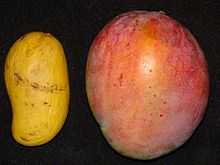Ataulfo (mango)

The Ataúlfo, also called young, baby, yellow, honey,[1][2] Adaulfo,[3] Adolfo,[4] or Champagne is a mango cultivar from Mexico.[5] Ataulfo mangos are golden yellow and generally weigh between 6 and 10 ounces (170 and 280 g), with a somewhat sigmoid (oblong) shape[5] and a gold-blushed yellow skin.[1] Their buttery flesh is not fibrous, and they have a thin pit.[5][6] Their flesh is a deep yellow and high in sugar (15 grams per 100-gram serving), with a rich, sweet flavor.[5][6] They are rich in vitamin C and dietary fiber.[1]
Origin
The Mexican Institute of Industrial Property (Instituto Mexicano de la Propiedad Industrial) granted the designation of origin of this fruit to the government of Chiapas. The land where this Mango was found was owned by Mr. Manuel Rodriguez until 1948 when Mr. Ataulfo Morales (who worked as a jeweler) bought the property and mango trees were already there. Since 1950 mango trees began to attract the attention of people. In 1958 the agronomist Hector Cano Flores (the discoverer of Ataulfo Mango), Head of Sector extinct Mexican Coffee Institute, began to do research. The Engineer Cano made a clone of Mango Ataulfo called IMC-M2. Shortly later the whole plant material is transferred from INMECAFE (Spanish: Instituto Mexicano Del Cafe. English: Mexican Coffee Institute) to the National Commission of _________ and went from there spreading this Mango. Years later, the grown to be known as "Ataulfo", the name by which the Engineer Cano christened this Mango.
Another possible explanation for the existence of these Mango is the fact that Chiapas, together with Guerrero, Sinaloa and Jalisco were the provinces where Filipinos settled after participating in the Manila Galleon trade. It could be that Filipino mestizo families planted these trees. The Ataulfo Mango species is similar to the Philippine Mango: The skin thin, the fragrace sweet, the fiber soft, and the trees continuously bear fruit from 5 years to over 80 years--- even reaching a century. During the Spanish colonial period in the Philippines, the people considered the fruit Mango the most beautiful fruit in the world. Before the Americans invaded in 1898, Filipinos would call their women, "bonita" or "bella" or "guapa"--- but the most beautiful they would say "Que manga es!"--- similar to how Mexicans would say the phrase.
Production
The fruit grows in warm, moist climates with summer rains, but monsoon isothermal oscillations must not suffer more than 41 °F. The proper temperature for this type of mango is 83 °F and rainfall between 1090–3000 mm annually, from April to October.
They come from the Mexican states of Michoacan, Sinaloa, Nayarit, Jalisco, Veracruz and Chiapas, and are sold between March and September.[1] In the Mexican state of Chiapas, mango production was, as of 2008, the sixth most important agricultural activity, based on cultivated surfaces, following corn, beans, coffee, sugar cane and cocoa. Ataulfo production in that state was concentrated in the Soconusco coastal region. Overall, producer organizations estimated that there were 18,000 hectares of Ataulfo mangoes in production in the state.[7]
Consumption
Ataulfo mangos gained popularity in the United States beginning in the late 1990s, though they have been a major crop in Mexico for decades.[5] As of 2009, they were the second-most popular variety of mango sold in the United States, behind the Tommy Atkins.[8]
References
- ↑ 1.0 1.1 1.2 1.3 Corey Mintz (May 24, 2008). "Sweet news: Ataulfos are in season; It's hard to believe these silky mangoes are related to the stringy variety we see in winter". Toronto Star.
- ↑ "Ataulfo Mango". Produce Oasis. May 2011.
- ↑ Tony Tantillo (September 16, 2008). "Yellow Mangoes". CBS3.com.
- ↑ Sue Doeden (April 26, 2009). "I'm mad about mangoes". Bemidji Pioneer.
- ↑ 5.0 5.1 5.2 5.3 5.4 Allen Susser. The Great Mango Book. Ten Speed Press (2001), p. 6 ISBN 1-58008-204-1.
- ↑ 6.0 6.1 Aliza Green. Starting with Ingredients. Running Press (2006), p. 572. ISBN 0-7624-2747-7.
- ↑ Patrick Hanemann, Nathanael Bourns, Ivana Fertziger (July 2008). "Ataulfo Mango in Chiapas: A Value Chain Analysis" (PDF). (USAID microREPORT #109
- ↑ Erica Marcus (June 10, 2009). "Mangoes win in popularity". St Louis Post-Dispatch.
| ||||||||||||||||||||||